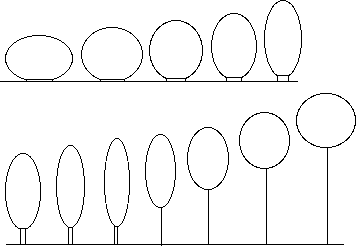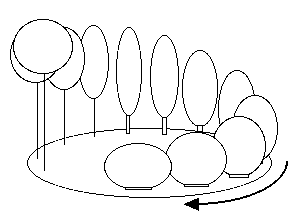Somewhere between a static turned piece, which may hint a movement by exploiting swirls and such in the figure in the wood,carving and piercing or inscirbing swirling lines - and sticking a piece on the end of a springy piece of wire, or hiding a little micro-robot under it that can make the piece crawl away, there's another way of adding movement, or the illusion of movement - and Walt Disney used it very well - and quite profitably. It's Cell Animation - and the idea has been around for a LONG LONG time.
Cell animation - applied to actual, rather than virtual, 3D. Hmmm. . . .
If you start with the idea of a bubble - sitting on a surface - rising up off that surface and into the air? Intially, the bottom of the bubble would stay stuck to the surface - and the shape, while still symetric about the vertical axis, would deform to an ovoid, getting taller but slenderer as it rises and tries to break free of the surface. Once it does, it will want to return to a sphere, more or less.
All the shapes lend themselves to turning - all with at least one axis of symetry.
Hmmmm . . .

A dozen turned pieces - mounted on a LayZSusan.
Hmmmmmm . . . Some small diameter piano/spring wire, a bit of judicious drilling and glueing . . .
Bob Macgregor, again from WoodCentral's Turning forum, suggested a carousel to mount the pieces on - that could be spun. LayZSusans are readility available.

Spin the LayZSusan and get something like this

Some interesting possibilities using the idea of Cell Animation. Wonder where that'll go.